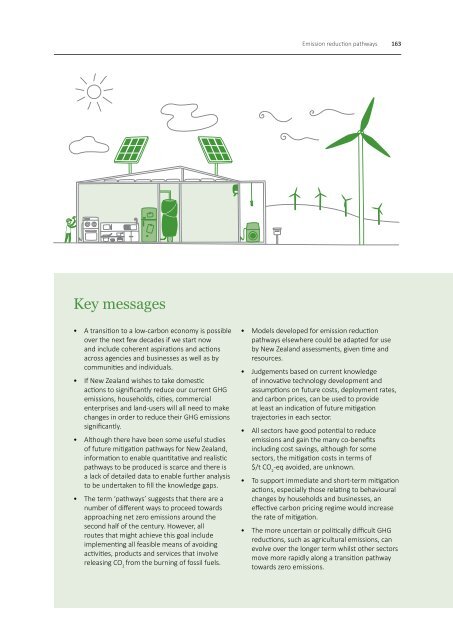Transition to a low-carbon economy for New Zealand
Report-Transition-to-Low-Carbon-Economy-for-NZ
Report-Transition-to-Low-Carbon-Economy-for-NZ
Create successful ePaper yourself
Turn your PDF publications into a flip-book with our unique Google optimized e-Paper software.
Emission reduction pathways 163<br />
Key messages<br />
• A transition <strong>to</strong> a <strong>low</strong>-<strong>carbon</strong> <strong>economy</strong> is possible<br />
over the next few decades if we start now<br />
and include coherent aspirations and actions<br />
across agencies and businesses as well as by<br />
communities and individuals.<br />
• If <strong>New</strong> <strong>Zealand</strong> wishes <strong>to</strong> take domestic<br />
actions <strong>to</strong> significantly reduce our current GHG<br />
emissions, households, cities, commercial<br />
enterprises and land-users will all need <strong>to</strong> make<br />
changes in order <strong>to</strong> reduce their GHG emissions<br />
significantly.<br />
• Although there have been some useful studies<br />
of future mitigation pathways <strong>for</strong> <strong>New</strong> <strong>Zealand</strong>,<br />
in<strong>for</strong>mation <strong>to</strong> enable quantitative and realistic<br />
pathways <strong>to</strong> be produced is scarce and there is<br />
a lack of detailed data <strong>to</strong> enable further analysis<br />
<strong>to</strong> be undertaken <strong>to</strong> fill the knowledge gaps.<br />
• The term ‘pathways’ suggests that there are a<br />
number of different ways <strong>to</strong> proceed <strong>to</strong>wards<br />
approaching net zero emissions around the<br />
second half of the century. However, all<br />
routes that might achieve this goal include<br />
implementing all feasible means of avoiding<br />
activities, products and services that involve<br />
releasing CO 2<br />
from the burning of fossil fuels.<br />
• Models developed <strong>for</strong> emission reduction<br />
pathways elsewhere could be adapted <strong>for</strong> use<br />
by <strong>New</strong> <strong>Zealand</strong> assessments, given time and<br />
resources.<br />
• Judgements based on current knowledge<br />
of innovative technology development and<br />
assumptions on future costs, deployment rates,<br />
and <strong>carbon</strong> prices, can be used <strong>to</strong> provide<br />
at least an indication of future mitigation<br />
trajec<strong>to</strong>ries in each sec<strong>to</strong>r.<br />
• All sec<strong>to</strong>rs have good potential <strong>to</strong> reduce<br />
emissions and gain the many co-benefits<br />
including cost savings, although <strong>for</strong> some<br />
sec<strong>to</strong>rs, the mitigation costs in terms of<br />
$/t CO 2<br />
-eq avoided, are unknown.<br />
• To support immediate and short-term mitigation<br />
actions, especially those relating <strong>to</strong> behavioural<br />
changes by households and businesses, an<br />
effective <strong>carbon</strong> pricing regime would increase<br />
the rate of mitigation.<br />
• The more uncertain or politically difficult GHG<br />
reductions, such as agricultural emissions, can<br />
evolve over the longer term whilst other sec<strong>to</strong>rs<br />
move more rapidly along a transition pathway<br />
<strong>to</strong>wards zero emissions.




